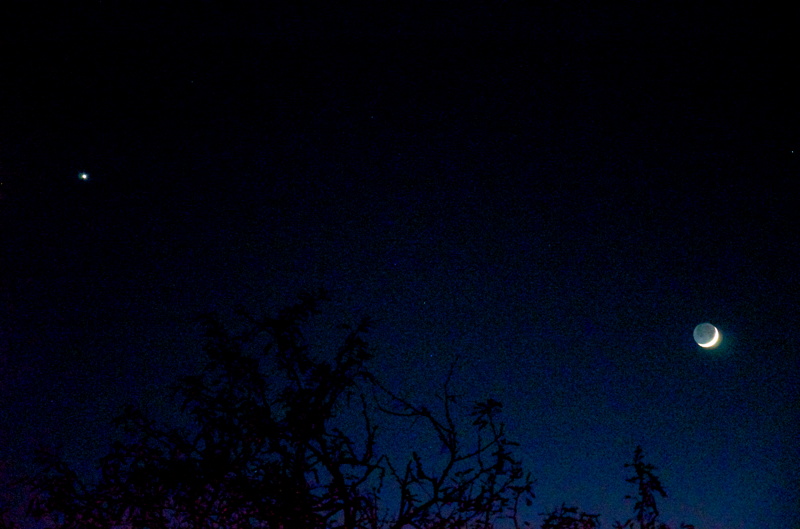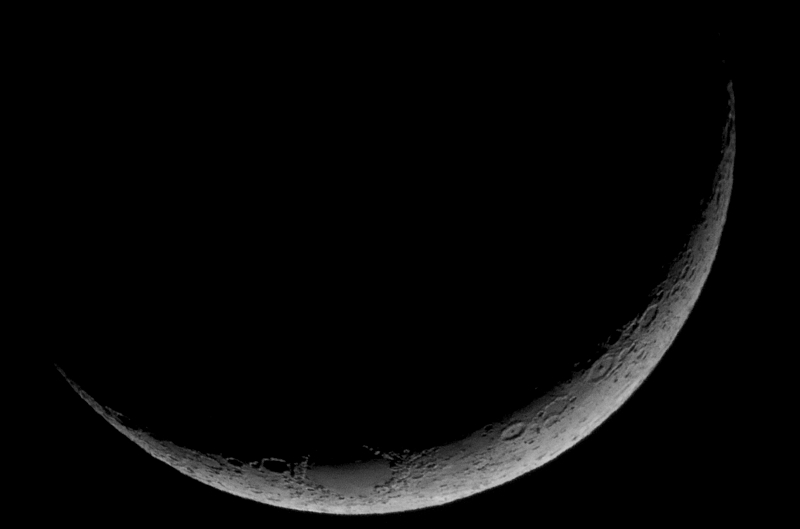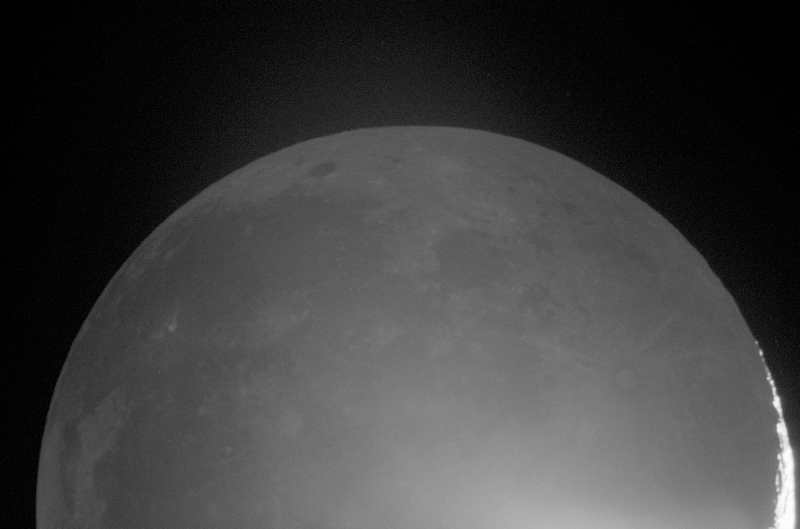
Venus and Crescent Moon,
Exploring M33 Triangulum Galaxy
Posted: 6 November 2013
Clouds and wind returned on Monday, 4 November 2013, with a brief thundershower after sunset. Rain continued on and off during the night. As sunset approached on Tuesday, 5 November, the sky began clearing. I headed out to the observatory after sunset and at 1809 MST, took this photo of Venus and the crescent moon (with Earthshine) above the observatory dome, f/3.5, 1/25sec, ISO 1600:

The observatory was opened at 1809 MST, 66°F. At 1815 MST, viewed the crescent moon, 83X. Earthshine was very nice. Then viewed Venus, 83X.
Took this photo of Venus and the moon at 1819 MST, f/5.3, 1/10sec, ISO 3200, 70mm, handheld:

I then began setting up for eyepiece projection astrophotography of Venus using a 9mm eyepiece (222X) on the 8" LX200-ACF. Seeing was not very good but I decided to try imaging anyway. I did several HD video recordings with the D7000 DSLR at various exposure settings. This is a crop from a recording, 1/500sec, ISO 3200, clearly showing the current phase of Venus:

With the moon getting very low in the western sky, took this prime focus image at 1840 MST, 1/250sec, ISO 3200:

This view of Earthshine was taken using the "Hat Trick" Method, 3.6 seconds, ISO 500, at 1844 MST:

At 1849 MST, slewed the 8" telescope to M33 (Triangulum Galaxy). I wanted to view Deep Sky Objects (DSO) in the galaxy, 2.8 Million Lightyears distant, as discussed in the article "Exploring the Triangulum Galaxy" by Ted Forte in the December 2013 issue of Sky & Telescope magazine (page 34). During several sessions in October 2013, I explored M31 Andromeda Galaxy for some of its DSOs. But the M33 DSOs would be an even neater accomplish. First, I checked M33 at 83X and then 222X. Poor seeing would hamper the observations somewhat. While waiting for M33 to rise a little higher in the eastern sky, I studied the S&T article. I then enabled "High Precision" GOTOs on the AutoStar to assist with locating the DSOs.
At 1902 MST, I picked up my first M33 DSO using 222X: NGC604. This H II star-forming region was easily seen as a large fuzzy patch. NGC595 was difficult and barely detectable using averted vision. NGC592 was easier and didn't require averted vision to see this small fuzzy patch. NGC588 appeared as a large fuzzy patch using averted vision. IC139 and IC140 were very difficult to view, especially IC139, but were seen as small faint fuzzy patches. IC137 was faintly visible with averted vision and was a very difficult object. IC136 was a faint patch intermittently seen using averted vision. I tried for IC135 but failed to locate it. IC142 was possibly seen using averted vision but I was not quite certain I was seeing it. At 1950 MST, I was finally able to confirm seeing the globular cluster C39 in M33. Using 222X, it was intermittently seen with averted vision as a small and very faint star-like object. I tried to see it at 133X and 83X, but it was not visible. I ended M33 DSO observing at 1958 MST.
This photo of M33 was taken in November 2011 using the D7000 DSLR at prime focus of the 8" telescope. Mouseover or tap on the image (if using a touchscreen) to see labels for the objects I observed.

The observatory was closed at 2010 MST, 52°F, relative humidity 44%.
Like to build a 70" telescope? This guy did!
Comments are welcome using Email. Thanks.
(Use of the LiveFyre comments system has been discontinued due to low usage.)
Cassiopeia Observatory Home Page